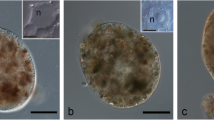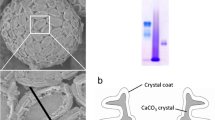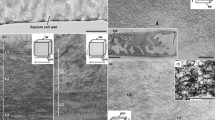Summary
Emiliania huxleyi is a marine coccolithophorid which produces coccoliths,i.e., particles consisting of calcite and macromolecular organic material. The coccoliths are formed intracellulary in specialized organelles which comprise a coccolith vesicle (CV) and a reticular body (RB), together forming the CV/RB system or calcifying system. After termination of calcification, the coccolith is extruded and incorporated into the coccosphere,i.e., one or several layers of extracellular coccoliths surrounding the cell. Apart from the coccolith-producing cells (C cells) ofE. huxleyi, there are naked cells (N cells) which seem to have lost the capacity to produce coccoliths but are very similar to the C cells in other morphological respects. Biochemical studies have revealed that polysaccharides may play a regulatory role in calcification. The aim of the present study was to determine the localization of polysaccharides in both C and N cells electron microscopically. For this purpose, a cytochemical staining technique according toThiéry (1967) was applied. The CV/RB system of C cells was conspicuously stained. Due to the excellent stainability of this system, a putative succession of morphological stages during coccolithogenesis could be described. The staining pattern of the N cells closely resembled that of the C cells. It was found, however, that the “calcifying” system of N and C cells differed in both morphology and position. It is suggested that the divergent morphology of the “calcifying” system of N cells accounts for its failure to produce coccoliths.
Similar content being viewed by others
References
Borman, A. H., de Jong, E. W., Huizinga, M., Kok, D. J., Westbroek, P., Bosch, L., 1982: The role in CaCO3 crystallization of an acid Ca2+-binding polysaccharide associated with coccoliths ofEmiliania huxleyi. Eur. J. Biochem.129, 179–183.
Braarud, T., Ringdal Gaarder, K., Markali, J., Nordli, E., 1952: Coccolithophorids studied in the electron microscope. Observations onCoccolithus huxleyi andSyracosphaera carterae. Nytt. Mag. Botan.1, 129–133.
De Bruyn, W. C., den Breejen, P., 1976: Glycogen its chemistry and morphological appearance in the electron microscope. III. Identification of the tissue ligands involved in the glycogen contrast staining reaction with osmium (IV)-iron(II) complex. Histochemical Journal8, 121–142.
De Jong, E. W., 1975: Isolation and characterization of polysaccharides associated with coccoliths. Ph.D. Thesis, State University of Leiden, The Netherlands.
—,Bosch, L., Westbroek, P., 1976: Isolation and characterization of a Ca2+-binding polysaccharide associated with coccoliths ofEmiliania huxleyi (Lohmann) Kamptner. Eur. J. Biochem.70, 611–621.
—,van Rens, L., Westbroek, P., Bosch, L., 1979: Biocalcification by the marine algaEmiliania huxleyi (Lohmann) Kamptner. Eur. J. Biochem.99, 559–567.
Fichtinger-Schepman, A. M. J., Kamerling, J. P., Versluis, C., Vliegenthart, J. F. G., 1981: Structural studies of the methylated, acidic polysaccharide associated with coccoliths ofEmiliania huxleyi (Lohmann) Kamptner. Carbohydrate Res.93, 105–123.
Hibberd, D. J., 1976: The ultrastructure and taxonomy of theChrysophyceae andPrymnesiophyceae (Haptophyceae): A survey with some new observations on the ultrastructure of theChrysophyceae. Botanical J. Linnean Soc.72, 55–80.
Hirsch, J. G., Fedorko, M. E., 1968: Ultrastructure of human leukocytes after simultaneous fixation with glutaraldehyde and osmium tetroxide and “postfixation” in uranyl acetate. J. Cell Biol.38, 615–627.
Klaveness, D., 1972 a:Coccolithus huxleyi (Lohmann) Kamptner. I. Morphological investigations on the vegetative cell and the process of coccolith formation. Protistologica8, 335–346.
—, 1972 b:Coccolithus huxleyi (Lohmann) Kamptner. II. The flagellate cell, aberrant cell types, vegetative propagation and life cycles. Br. Phycol. J.7, 309–318.
—, 1976:Emiliania huxleyi (Lohmann) Hay & Mohler. III. Mineral deposition and the origin of the matrix during coccolith formation. Protistologica12, 217–224.
—,Paasche, E., 1971: Two differentCoccolithus huxleyi cell types incapable of coccolith formation. Arch. Mikrobiol.75, 382–385.
— —, 1979: Physiology of Coccolithophorids. In: Biochemistry and Physiology of Protozoa, Vol. 1, 2nd ed. (Levandowsky, M., Hutner, S. H., eds.), pp. 191–213. New York: Academic Press.
Manton, I., Leedale, G. F., 1969: Observations on the microanatomy ofCoccolithus pelagicus andCricosphaera carterae, with special reference to the origin and nature of coccoliths and scales. J. marine biol. Ass. U.K.49, 1–16.
Rambourg, A., 1973: Staining of intracellular glycoproteins. In: Electron Microscopy and Cytochemistry (Wisse, E., Daems, W. Th., Molenaar, I., Van Duyn, eds.), pp. 245–253. Amsterdam: North-Holland.
Schachter, H., 1974: The subcellular sites of glycosylation. Bioch. Soc. Symp.40, 57–71.
Schade, H. A. R., 1973: On the staining of glycogen for electron microscopy with polyacids of tungsten and molybdenum. I. Direct staining of sections of osmium-fixed and Epon-embedded mouse liver with aqueous solutions of phosphotungstic acid (PTA). In: Electron Microscopy and Cytochemistry (Wisse, E., Deams, W. Th., Molenaar, I., Van Duyn, P., eds.), pp. 263–266. Amsterdam: North-Holland.
Sikes, C. S., Wheeler, A. P., 1983: A systematic approach to some fundamental questions of carbonate calcification. In: Biomineralization and Biological Metal Accumulation (Westbroek, P., de Jong, E. W., eds.), pp. 285–289. Dordrecht: Reidel.
Thiéry, J.-P., 1967: Mise en evidence des polysaccharides sur coupes fines en microscopie électronique. J. Microscopie6, 987–1018.
Vian, B., Roland, J. C., 1972: Différenciation des cytomembranes et renouvellement du plasmalemma dans les phénomènes de sécrétions végétales. J. Microscopie13, 119–136.
Watabe, N., 1967: Crystallographic analysis of the coccolith ofCoccolithus huxleyi. Calc. Tiss. Res.1, 114–121.
Wilbur, K. M., Watabe, N., 1963: Experimental studies in calcification in molluscs and the algaCoccolithus huxleyi. Ann. N.Y. Acad. Sci.109, 82–112.
Author information
Authors and Affiliations
Rights and permissions
About this article
Cite this article
van der Wal, P., de Jong, E.W., Westbroek, P. et al. Ultrastructural polysaccharide localization in calcifying and naked cells of the coccolithophoridEmiliania huxleyi . Protoplasma 118, 157–168 (1983). https://doi.org/10.1007/BF01293073
Received:
Accepted:
Issue Date:
DOI: https://doi.org/10.1007/BF01293073




